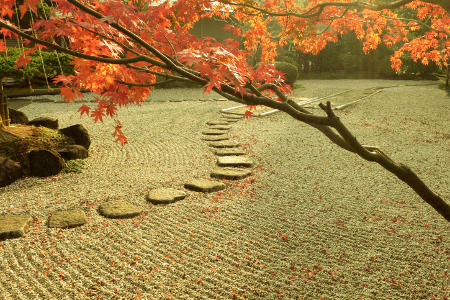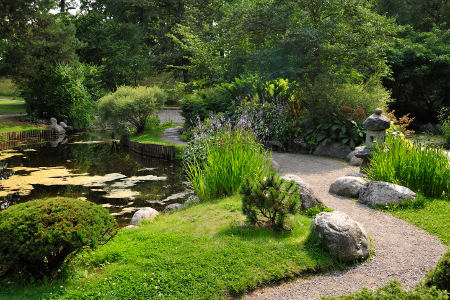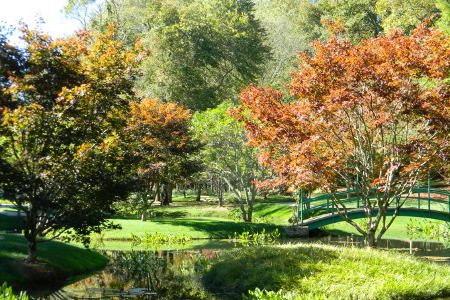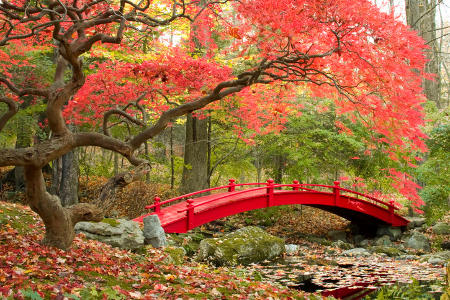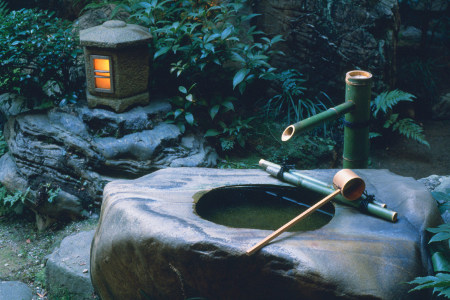Japanese gardens spell tranquility, beauty and most importantly, stand for the balance found in nature. If you wish to recreate a space where you can meditate and rewind after a hard day's work, transforming your garden, keeping in mind the Japanese theme, will do wonders for you and your spirit.
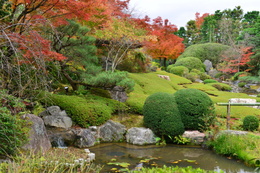
One doesn't need an introduction to a garden; nevertheless, I will begin with a quote by William Kent,
"A garden is to be a world unto itself, it had better make room for the darker shades of feeling as well as the sunny ones." A garden, thus, understood is a place that distills harmony and comfort while adding to the aesthetic pleasure. Japanese gardens for that matter, are traditional gardens that create miniature landscapes and if you have been to a Japanese garden, then the first thing that you would notice is the simplicity of the layout. The entire area distills in you, a soothing peace, while the rocks and the flowing stream take away all negation and successfully purge your spirit.
Recreating a Japanese garden is an arduous yet satisfactory task. For those of you who have a sprawling backyard, transforming it into a majestic Japanese garden won't pose much of a problem; and for those of you facing a space crunch, you can go in for the indoor Japanese garden.
Building a Japanese Garden
"The life of man in every part has need of harmony and rhythm." - Plato
Japanese are known to appreciate the elements of nature, and their gardens respect the basic rule of nature, that is, of change. Japanese gardens are known to soothe the soul with their timeless beauty. Given below are simple knickknacks that will help you transform your backyard into a tranquil Japanese garden.


Elements and their Symbolism
A Japanese garden reflects the perfect balance found in nature. In order to recreate the natural surroundings, you would need
rocks and
stones to represent individual islands, hills and mountains. A few
trees and
shrubs will represent nature in abundance. A
water feature will represent purity, serenity and flow that is a part of nature. A wooden or stone
bridge will represent immortality, and an escape to paradise is an absolute must for a Japanese garden.
Pathways and
stairs represent a journey of the soul, and
lanterns or
religious artifacts that represent the elements of Buddhist cosmology form the basic elements of a Zen garden.
Prior Planning
Owning a sprawling lawn will definitely benefit you, as it will offer you maximum space to experiment with the layout. However, if you have a relatively smaller backyard, you would have to meticulously plan the arrangement of the garden. Depending on the space available, you would have to decide on how formal you want your garden to be. You wouldn't want your garden to look too dressy, as the resultant garden should reflect the Japanese culture. Purchase the materials and decorations as per the garden size. Remember,
minimalistic is the key word in a Japanese garden.
Lay the Stones
The first step to create a Japanese garden is to design the walkway or paths using the stepping stones. Ideally, the stones should be clubbed in groups of odd digits (i.e., in groups of 3, 5, 7, 9, etc.). A safe bet is to make triangular arrangements of the rocks. Stepping stones add beauty to a walkway; moreover, large stones interspersed in the pathway is indicative of rest and stillness just so that you can take in the beauty of the garden. When creating the pathway, use at least two stones of the same shape and size. You can even create stone sculptures or simple mounds made of three stones with varying sizes.
Line with Foliage
Once you are done with the pathway, decorate the area around them with flowering plants, shrubs and trees. If you have a huge courtyard, plant trees like maple, coast redwoods, Japanese junipers, etc. The ideal setup would be to plant trees and select plants according to their colors and their seasons; however, plants in all hues are welcome. Flowering plants like that of chrysanthemums, lilies and daisies add to the visual appeal of the garden. You can even plant yew hedges to line your garden fences. For the ground covering, use Japanese garden plants like baby's tears, spurge, ardisia and sweet flag.
Embed a Water Feature
Japan is an island and creating a water feature is an absolute must for a Japanese garden. If you have a sloping terrain, creating a waterfall with rocks is an easier option. You can even consider installing a Koi pond, if your backyard is really huge. If you do not own a sprawling area, then you can go in for a simple water pond, made with bamboo which can be operated using simple mechanics. For your benefit, given alongside is a diagram of a simple pond. Water features should face a seating area, as observing running water instills a sense of peace and tranquility.
Complete with Decorations
Light up the pathway with stone lanterns or throw in some authentic Japanese furniture. Invest in a few Japanese pagodas to breathe life into your gardenand make it look authentic. Remember to keep it minimalistic though, for you wouldn't want your garden to look like a museum of artifacts!
It is absolutely fine if you do not put in any decorations or leave a part of the garden empty, as empty portions in a garden are key elements of a Zen garden.
Interior Garden Layout
If you do not own a backyard and still want to implement the Japanese garden theme, you can create a garden on your terrace or better still, use up the space below your stairs to create a miniature garden. To create the garden, all you have to do is pattern the stones around the stairs, and use a few bonsai and potted plants to create your very own Japanese garden at home. You can even put in a custom-built water fountain to add to the aesthetic beauty of your home.
I hope these ideas will help you redecorate your garden or home interiors. Besides, do not forget to add a garden fence to make your garden a private space, where you can meditate peacefully.






 One doesn't need an introduction to a garden; nevertheless, I will begin with a quote by William Kent, "A garden is to be a world unto itself, it had better make room for the darker shades of feeling as well as the sunny ones." A garden, thus, understood is a place that distills harmony and comfort while adding to the aesthetic pleasure. Japanese gardens for that matter, are traditional gardens that create miniature landscapes and if you have been to a Japanese garden, then the first thing that you would notice is the simplicity of the layout. The entire area distills in you, a soothing peace, while the rocks and the flowing stream take away all negation and successfully purge your spirit.
One doesn't need an introduction to a garden; nevertheless, I will begin with a quote by William Kent, "A garden is to be a world unto itself, it had better make room for the darker shades of feeling as well as the sunny ones." A garden, thus, understood is a place that distills harmony and comfort while adding to the aesthetic pleasure. Japanese gardens for that matter, are traditional gardens that create miniature landscapes and if you have been to a Japanese garden, then the first thing that you would notice is the simplicity of the layout. The entire area distills in you, a soothing peace, while the rocks and the flowing stream take away all negation and successfully purge your spirit.